CMEs impact, geomagnetic storms reaching G4 Severe in progress
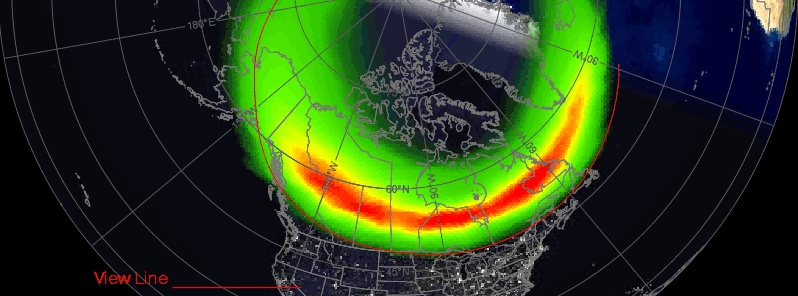
A sequence of events led to an Earth-directed asymmetric halo CME on March 15, 2015. The events began with a 14 degree long filament eruption, centered near S24W38, lifting off between 00:45 to 02:00 UTC. This was followed by C2.4 flare at 00:41 UTC and a long duration C9.1 at 02:13 UTC, both from Region 2297.
Associated with the C9.1 flare were low-frequency radio emissions including Type II (estimated velocity 745 km/s) and Type IV radio sweeps. WSA/ENLIL modelling showed an approximate arrival time around 20:00 on March 17. However, it appears this CME arrived some 16 hours earlier (see update #2 and #4).
An interplanetary shock wave arrived at the ACE spacecraft around 04:15 UTC and at Earth a half hour later.
Geomagnetic K-index of 5 (G1 – Minor) threshold was reached at 05:59 UTC. Potential impacts: Area of impact primarily poleward of 60 degrees Geomagnetic Latitude. Weak power grid fluctuations can occur. Minor impact on satellite operations are possible. Aurora may be visible at high latitudes, i.e., northern tier of the U.S. such as northern Michigan and Maine.
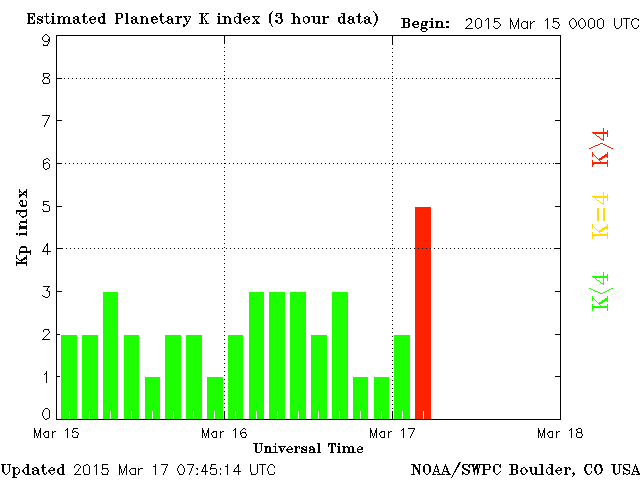
A G2 – Moderate geomagnetic storm warning has been issued based on solar wind signatures at the ACE spacecraft. Under G2 conditions, area of impact is primarily poleward of 55 degrees Geomagnetic Latitude. Power grid fluctuations can occur. High-latitude power systems may experience voltage alarms. Satellite orientation irregularities may occur; increased drag on low Earth-orbit satellites is possible. HF (high frequency) radio propagation can fade at higher latitudes. Aurora may be seen as low as New York to Wisconsin to Washington state.
Update #1:
Geomagnetic K-index of 6 (G2 Moderate geomagnetic storm) threshold was reached at 08:46 UTC.
Update #2:
Initial SWPC's diagnosis suggested the arrival of the anticipated CME from March 15, however, the subsequent temperature and density measurements pointed towards a recurrent negative polarity coronal hole high speed solar wind stream (CH HSS).
The disturbed conditions may be the combined effects of the high speed stream and CME.
Geomagnetic K-index of 7 or greater (G3 or greater – Strong to Extreme) is expected as the impacts from today's shock continue.
Update #3:
Geomagnetic K-index of 8 (G4 Severe) threshold was reached at 13:58 UTC.
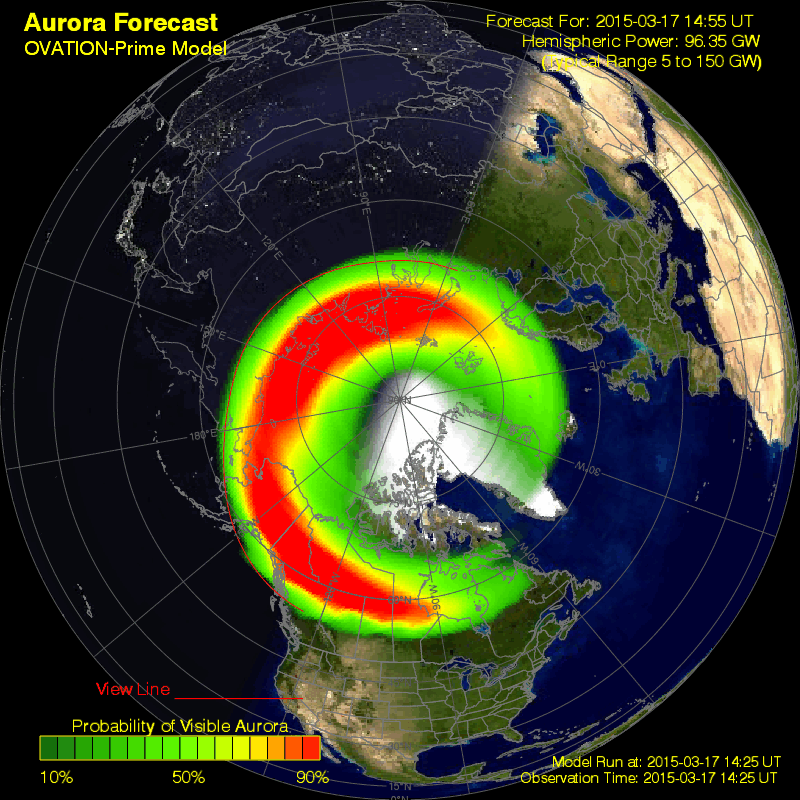
Area of impact primarily poleward of 45 degrees Geomagnetic Latitude.
Induced currents – Possible widespread voltage control problems and some protective systems may mistakenly trip out key assets from the power grid. Induced pipeline currents intensify.
Spacecraft systems may experience surface charging; increased drag on low earth orbit satellites, and tracking and orientation problems may occur.
Satellite navigation (GPS) degraded or inoperable for hours.
HF (high frequency) radio propagation sporadic or blacked out.
Aurora may be seen as low as Alabama and northern California.
Update #4 (March 18):
The severe geomagnetic storm on March 17 was finally identified as the combined effects of CMEs from March 15.
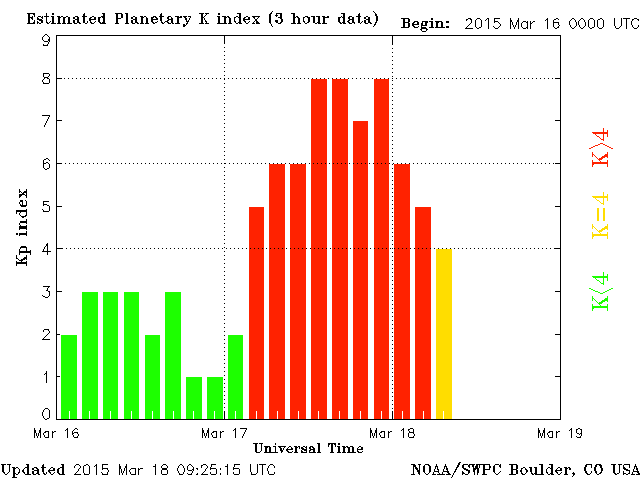
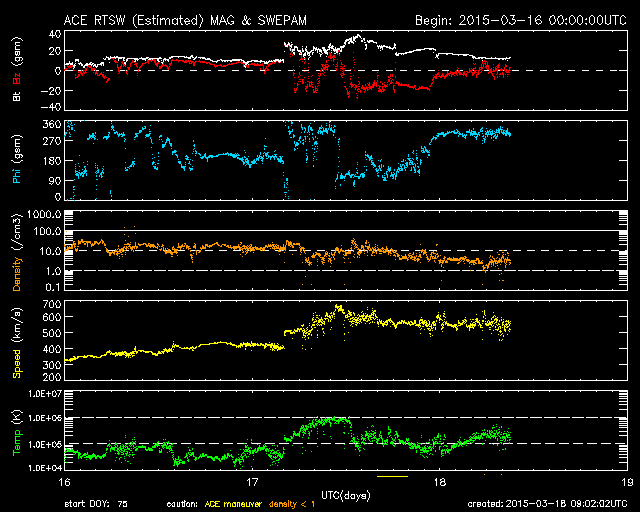
Note: This was the strongest geomagnetic storm of the current solar cycle. Images and videos of auroras it sparked can be found here.
* end of updates *
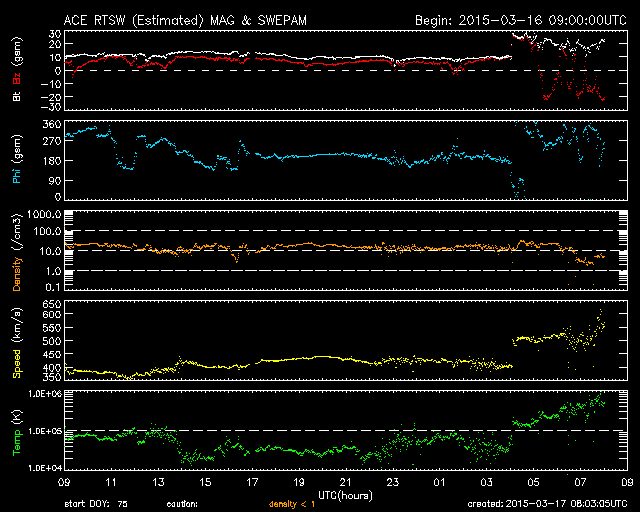
Space Weather Message Code: SUMSUD
Serial Number: 204
Issue Time: 2015 Mar 17 0831 UTC
SUMMARY: Geomagnetic Sudden Impulse
Observed: 2015 Mar 17 0445 UTC
Deviation: 54 nT
Station: BOU
Comment: CORRECTED previous summary for Observed Time.
NOAA Space Weather Scale descriptions can be found at
www.swpc.noaa.gov/noaa-scales-explanation
Space Weather Message Code: ALTK05
Serial Number: 772
Issue Time: 2015 Mar 17 0609 UTC
ALERT: Geomagnetic K-index of 5
Threshold Reached: 2015 Mar 17 0559 UTC
Synoptic Period: 0300-0600 UTC
Active Warning: Yes
NOAA Scale: G1 - Minor
NOAA Space Weather Scale descriptions can be found at
www.swpc.noaa.gov/noaa-scales-explanation
Potential Impacts: Area of impact primarily poleward of 60 degrees Geomagnetic Latitude.
Induced Currents - Weak power grid fluctuations can occur.
Spacecraft - Minor impact on satellite operations possible.
Aurora - Aurora may be visible at high latitudes, i.e., northern tier of the U.S. such as northern Michigan and Maine.
Space Weather Message Code: WARK06
Serial Number: 255
Issue Time: 2015 Mar 17 0533 UTC
WARNING: Geomagnetic K-Index of 6 expected
Valid From: 2015 Mar 17 0545 UTC
Valid To: 2015 Mar 17 1000 UTC
Warning Condition: Onset
NOAA Scale: G2 - Moderate
NOAA Space Weather Scale descriptions can be found at
www.swpc.noaa.gov/noaa-scales-explanation
Potential Impacts: Area of impact primarily poleward of 55 degrees Geomagnetic Latitude.
Induced Currents - Power grid fluctuations can occur. High-latitude power systems may experience voltage alarms.
Spacecraft - Satellite orientation irregularities may occur; increased drag on low Earth-orbit satellites is possible.
Radio - HF (high frequency) radio propagation can fade at higher latitudes.
Aurora - Aurora may be seen as low as New York to Wisconsin to Washington state.
Space Weather Message Code: ALTK06
Serial Number: 328
Issue Time: 2015 Mar 17 0848 UTC
ALERT: Geomagnetic K-index of 6
Threshold Reached: 2015 Mar 17 0846 UTC
Synoptic Period: 0600-0900 UTC
Active Warning: Yes
NOAA Scale: G2 - Moderate
NOAA Space Weather Scale descriptions can be found at
www.swpc.noaa.gov/noaa-scales-explanation
Potential Impacts: Area of impact primarily poleward of 55 degrees Geomagnetic Latitude.
Induced Currents - Power grid fluctuations can occur. High-latitude power systems may experience voltage alarms.
Spacecraft - Satellite orientation irregularities may occur; increased drag on low Earth-orbit satellites is possible.
Radio - HF (high frequency) radio propagation can fade at higher latitudes.
Aurora - Aurora may be seen as low as New York to Wisconsin to Washington state.
Space Weather Message Code: WARK07
Serial Number: 46
Issue Time: 2015 Mar 17 1216 UTC
WARNING: Geomagnetic K-index of 7 or greater expected
Valid From: 2015 Mar 17 1215 UTC
Valid To: 2015 Mar 17 1700 UTC
Warning Condition: Onset
NOAA Scale: G3 or greater - Strong to Extreme
NOAA Space Weather Scale descriptions can be found at
www.swpc.noaa.gov/noaa-scales-explanation
Potential Impacts: Area of impact primarily poleward of 50 degrees Geomagnetic Latitude.
Induced Currents - Power system voltage irregularities possible, false alarms may be triggered on some protection devices.
Spacecraft - Systems may experience surface charging; increased drag on low Earth-orbit satellites and orientation problems may occur.
Navigation - Intermittent satellite navigation (GPS) problems, including loss-of-lock and increased range error may occur.
Radio - HF (high frequency) radio may be intermittent.
Aurora - Aurora may be seen as low as Pennsylvania to Iowa to Oregon.
Space Weather Message Code: ALTK08
Serial Number: 18
Issue Time: 2015 Mar 17 1401 UTC
ALERT: Geomagnetic K-index of 8
Threshold Reached: 2015 Mar 17 1358 UTC
Synoptic Period: 1200-1500 UTC
Active Warning: Yes
NOAA Scale: G4 - Severe
NOAA Space Weather Scale descriptions can be found at
www.swpc.noaa.gov/noaa-scales-
Featured image: Aurora Forecast, OVATION-Prime Model run at 08:15 UTC on March 17, 2015.

I’m just curious about all of the magnetic changes that our north and south poles are experiencing have they tilted off balance?